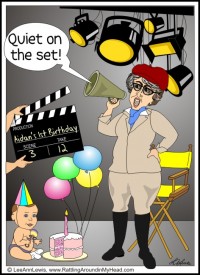
Quiet on the Set!
My Own Silent Film Era
In this video-crazed, You-Tube day and age, you might not believe this, but I was eleven years old the first time I ever heard the sound of my own voice. It's true. Some kid in my neighborhood got a reel-to-reel tape recorder for his birthday (the first one I'd ever seen in person) and he let me try it out.
I don't recall exactly what I said when he pressed the "Record” button – probably something brilliant like "Testing one, two, three”, but I do remember two things vividly. First, I was nervous as a cat, and second I didn't even recognize myself when he played it back. This, of course, led me to declare his new gadget "a piece of junk”, a charge he angrily disputed – and to prove it he tried the machine out on everybody else on our block. When they all sounded exactly the same as they did in real life I was forced to concede that maybe, just maybe it wasn't the tape after all, but was my very own voice that sounded so weird.
I was thinking about this event recently as I watched the highly acclaimed Academy Award-winner "The Artist”, a movie about the silent film era that was actually a silent movie itself. Turns out I actually have a lot in common with the film in that every single one of my own home movies was silent too!
 Now obviously the movies my parents took with their trusty little 8mm camera weren't exactly the same as the motion pictures Hollywood was churning out in the twenties. For one thing, ours were not in black and white. They also didn't have title cards, nobody played a rinky-tink piano to accompany them, and they didn't have all those exaggerated facial expressions – well, except for the time my uncle caught my aunt on film as she emerged unsuspecting from a campground bath house wearing a purple terrycloth robe and rubber galoshes. (Talk about facial expressions!)
Now obviously the movies my parents took with their trusty little 8mm camera weren't exactly the same as the motion pictures Hollywood was churning out in the twenties. For one thing, ours were not in black and white. They also didn't have title cards, nobody played a rinky-tink piano to accompany them, and they didn't have all those exaggerated facial expressions – well, except for the time my uncle caught my aunt on film as she emerged unsuspecting from a campground bath house wearing a purple terrycloth robe and rubber galoshes. (Talk about facial expressions!)
But while our little home movies may have lacked the technical elements of a major studio production, when it came to creative cinematography, D.W. Griffith had nothing on my Dad. Witness the clip of my grandfather, who leaned a rake against the barn and then proceeded to walk backward toward the house, going up the porch steps (still backward) and slowly easing himself into an old metal rocker – all so it would appear that this particular piece of film was somehow being shown in reverse!
You could see everybody cracking up in hysterics as he did it, and I only wish I could have heard the laughter. But then, that's the one of the biggest drawbacks to silent movies. As far as I know, there's not a single recording of my sweet grandmother's hearty chuckle. Nor are there any audible soundtracks of my grandfather playing the fiddle or the banjo, two instruments at which he was an incredible virtuoso. But I think the thing that saddens me most is that I have no keepsake of my own voice as a little girl.
For a person who loves talking as much as I do (sometimes I even get paid for it), not to mention having the kind of memory that affords me almost total recall of my past, it seems strange to have this one big gaping hole in my personal history. The very fact that I don't know what I sounded like makes me even more curious to know what I sounded like! Was my voice high-pitched and sing-songy or sort of low and gravelly? Did I clip my ‘r's? Could I carry a tune at age four?
The worst part about all of this is that the very same plight was visited on my own two kids, because my husband and I shot all of our home movies on silent Super 8 film as well. Fortunately, when Lauren was six and Jason was three, my brother-in-law bought one of those new-fangled "camcorders” so at least we have a few videos where I can hear their sweet little voices. Their baby babblings and first words and silly toddler songs, however, were never captured, which means that I watch footage of their earliest years in complete silence, just as I watch movies of myself as a little girl in complete silence.
But odd as it may seem, there can be a certain charm in viewing the past this way. In fact, what I've found is that if I sit very still and allow myself to really engage with the precious friends and family coming to life on my screen, even though it's perfectly quiet, from somewhere deep within my own memory I can actually hear the sound of their voices. And in that moment, silence truly does become golden.
So the next time you watch an old home movie, don't sit there griping because it doesn't have sound. Try being quiet yourself instead. The voices are there, I promise. You just have to know where to listen.
- Search for Oddly Enough articles similar to "Quiet on the Set!.
- Search all articles similar to "Quiet on the Set!".
- List all Oddly Enough articles.
Terms & Conditions | Contact | Login | This website designed by Shawn Olson